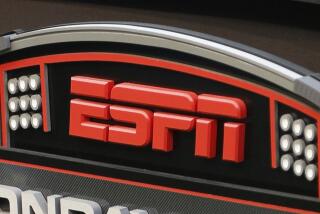New Definition for TV
- Share via
PITTSBURGH — The 12,508 fans who streamed into Pitt’s arena for the nationally ranked Panthers’ final home basketball game earlier this month didn’t realize they were about to witness television history.
Only a few hundred feet from the playing court, before the watchful eyes of a few executives and technical hands in a production van so new that the price tags were still being snipped off, the way America watches sports on television may have altered forever.
There were no announcers, no commercials, no ratings and, essentially, no viewers. The only eyewitnesses were the 100 or so responsible for the first high definition sports telecast in ESPN history.
The production that night won’t be shown on the air -- it was done solely to acclimate the directors, cameramen and technicians to the wider image they soon will bring to viewers. Images flowed through cameras so complex they cost about a half-million dollars apiece, into specially designed trucks that cost many times that amount and, finally, via satellite to a new production center in Connecticut that will cost about as much as it did to launch ESPN itself in 1979.
They won’t be practicing when ESPN’s high definition channel signs on March 30 with the Rangers-Angels season opener, even if there initially may not be many more viewers than those who carefully scrutinized that Seton Hall-Pitt game.
The broadcast industry has waited for years for the so-called “killer app” -- the “Gee-I’ve-got-to-have-that-now” vehicle that compels millions of consumers to trash their analog TVs, and a technology that hasn’t changed for more than a half-century, and step into the brave new world of high definition.
ESPN, which will show all four major pro team sports on a channel it calls “The Big Picture in Sports,” thinks ESPN HD will be just that vehicle. Those in charge aren’t too modest to speculate what the channel’s impact will be -- even if that influence, much like that of the original ESPN itself, may not be felt fully for years.
“There’s no pressure in what we’re doing,” said Bryan Burns, the ESPN vice president in charge of launching the channel. “We’re only talking about the future of television as we’ll know it.”
Jed Drake, ESPN’s senior vice president and executive producer, is no less convinced how the channel will feed the American public’s insatiable appetite for sports on TV.
“We’re going to drive the market. This is going to change the way people watch sports on TV,” Drake said. “When people see what we’re doing, they’re going to go crazy.”
First, of course, people must see what they’re doing and, for now, that’s the biggest challenge in starting a channel that will telecast 100 live events this year in high definition’s movie-like widescreen picture and six-channel surround sound.
HDTV’s big selling point, of course, is the three dimensional-like picture quality -- six times sharper than the analog sets Americans have watched since “Howdy Doody” drew big ratings and Steve Allen hosted “The Tonight Show.”
ESPN HD isn’t the pioneer in the field; Dallas Mavericks owner Mark Cuban’s HDNet, carried by DirecTV and some cable companies, has shown hundreds of major league baseball, NHL, college football and basketball games in the last 18 months. Also, CBS (Masters, NCAA Final Four, NFL playoff games, weekly Saturday college football), ABC (Super Bowl, with the NBA and NHL finals to come this spring and Monday night football this fall) and NBC (Triple Crown racing) are showing big-ticket sporting events in high definition.
It’s not just sports that’s in high definition, either. The bulk of the prime-time programming on CBS and ABC is in high def. Jay Leno has been in HDTV for years; David Letterman and Conan O’Brien go high def this fall.
Still, even though HDTV sets have been on the market for a few years, many Americans not only haven’t seen them, they don’t know they exist. About half those questioned in several industry polls were unaware the federal government has mandated that all TV stations must replace their analog signals with digital broadcasts by 2006.
Once viewers see a high definition TV, properly set up and with compelling programming such as the Super Bowl, they seem to get hooked quickly.
“And the more they see this, the more they’re going to want it,” Burns said.
Until now, HDTV prices in the $3,000 to $5,000 price range scared off many consumers. However, set prices have dropped in half over the last two years (big screen HDTV sets are available for $1,500), resulting in higher-than-expected sales of 2.7 million digital sets last year. Currently, 4% of all U.S. households have HDTV sets; that number may double as early as next year.
“Everything is going to change when ESPN goes high definition,” Burns said. “Everything.”
More to Read
Go beyond the scoreboard
Get the latest on L.A.'s teams in the daily Sports Report newsletter.
You may occasionally receive promotional content from the Los Angeles Times.






